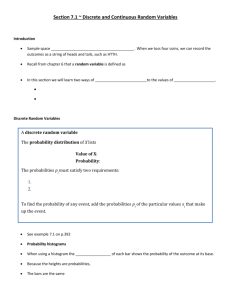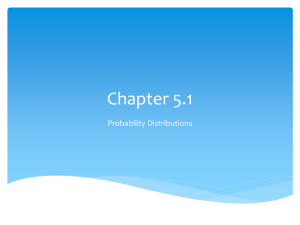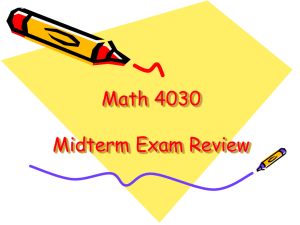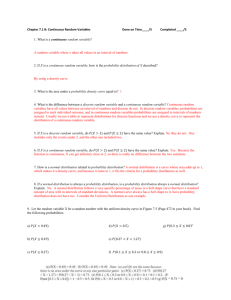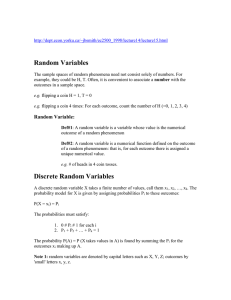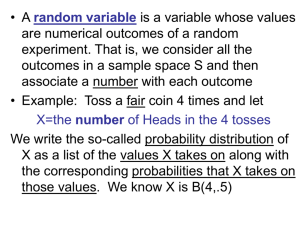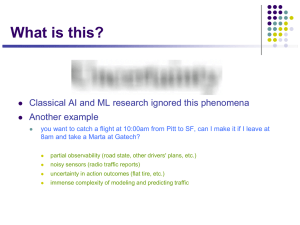Powerpoint 7.1
advertisement
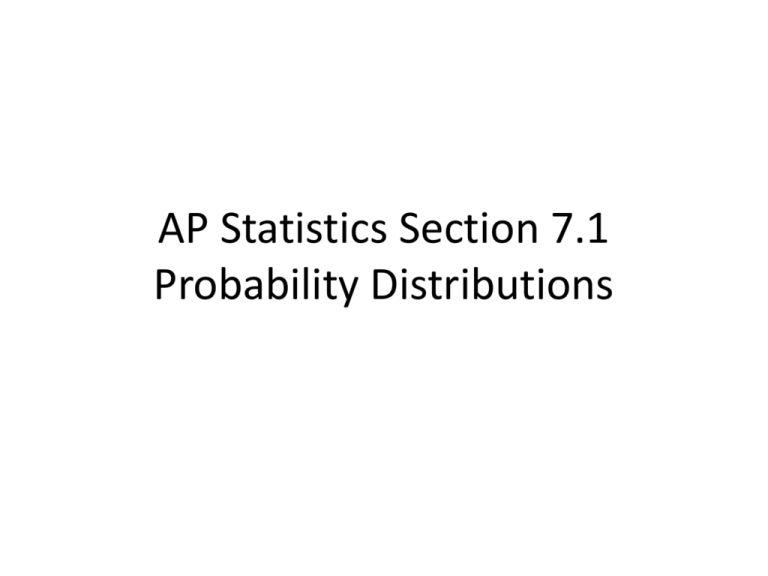
AP Statistics Section 7.1 Probability Distributions Consider tossing two 4-sided dice. What is the sample space? 1-1 1-2 1-3 1-4 2-1 2-2 2-3 2-4 3-1 3-2 3-3 3-4 4-1 4-2 4-3 4-4 We are often interested in numerical outcomes in statistics. Let X equal the sum of the two 4sided dice. What are the only possible values of X? 2, 3, 4, 5, 6, 7, 8 Since the value of X will vary from roll to roll, we call X a ________ random variable. A random variable is a variable whose value is a numerical outcome of some random phenomenon. A discrete random variable is a random variable with a countable number of possible outcomes. The probability distribution of a discrete random variable X lists the possible values of X along with their probabilities. Value of x x1 Probability p1 x2 p2 x3 ….. p3 ….. xk pk The probabilities must satisfy two requirements: 1. Every probability is a number between ___ 0 and ___. 1 2. The sum of the probabilities is _____ 1 (i.e p p p 1 ) 1 2 k Example: Construct the probability distribution for the sum of two 4-sided dice. X 2 3 4 5 6 7 8 P(X) .0625 .125 .1875 .25 .1875 .125 .0625 .625 P(sum is less than 6) = _________ .9375 P(sum is at least 3) = __________ Example: What is the probability distribution of the discrete random variable X that counts the number of heads in four tosses of a coin? HHHH THHH HTHH HHTH HHHT P( X 3) TTHH THTH THHT HTTH HTHT HHTT ________ .9375 HTTT THTT TTHT TTTH TTTT P(1 X 4) x P(x) 0 .0625 1 .25 2 .375 3 .25 4 .0625 ________ .875 We can draw a probability histogram for the discrete random variable’s distribution. 0 .4 Probability 0 .3 0 .2 0 .1 0 .0 0 1 2 # of Heads 3 4 What are possible values for the following two scenarios? Number of seniors at Bay High School 280, 281, 282,.... Average height of seniors at Bay High School Between 66" and 74' ' Could be 68.1 or 68.14 or 68.142 While the outcomes on the left are discrete the outcomes on the right are not because they are not countable numbers but an entire interval of numbers. A continuous random variable is a random variable which takes on all values in an interval on numbers. Because a continuous random variable can take on any value in some interval, it is impossible to talk about random variables using the same model as we did the discrete random variables above. For continuous random variables the probability distribution is described by a ____________. density curve *The probability of any event will be the area under the curve and above the values of X that make up the event. Since the sum of all the probabilities must be __ 1 the total area under the curve must be __. 1 A very “straight forward” density curve to work with is the uniform distribution, where outcomes are spread uniformly (i.e. evenly) across the interval. Example: The first BART train of the day is to arrive at the Golden Gate Station at 07:30. Arrival times are uniformly distributed between 07:29:45 and 07:30:30. Find... 1 45 P(the train is early) P( x 7 : 30) 7 : 30 : 30 7 : 29 : 45 (15)(1 / 45) 1 / 3 45 sec. P(the train is between 10 and 20 seconds late) P(7 : 30 : 10 x 7 : 30 : 20) (10)( 1 ) 10 2 45 45 9 P(the train arrives at exactly 0730) (0)( 1 )0 45 A continuous distribution assigns a probability of __0__ to each individual outcome. Hopefully you recall working with normal distributions back in Chapter 2. Normal distributions are probability distributions. Example: The random variable X represents the profit made on a randomly selected day by a certain store. Assume X is Normally distributed with a mean of $360 and standard deviation $50. (Our shorthand notation for this is ________) N (360,50) Find…. P ( X 400) z 360 50 400 360 .80 50 1 .7881 .2119 P ((250 X 450) .9502 Normalcdf (400,100000,360,50) Example: The random variable X represents the profit made on a randomly selected day by a certain store. Assume X is Normally distributed with a mean of $360 and standard deviation $50. The probability is approximately 0.6 that on a randomly selected day the store will make less than x0 amount of profit. Find x0 . .6 360 50 For .6, z .25 x - 360 .25 50 x 372.5 invNorm(.6,360,50) 372.67



